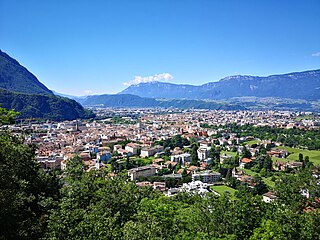
Bolzano is the capital city of the province of Bolzano - South Tyrol, in Northern Italy. With a population of 108,245, Bolzano is also by far the largest city in South Tyrol and the third largest in historical Tyrol. The greater metro area has about 250,000 inhabitants and is one of the urban centres within the Alps.
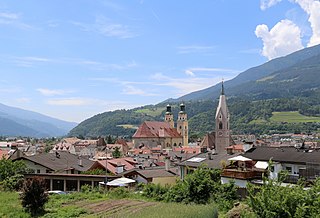
Brixen is a town and commune in South Tyrol, northern Italy, located about 40 kilometres (25 mi) north of Bolzano.

The Victory Monument is a monument in Bolzano, northernmost Italy, erected on the personal orders of Benito Mussolini in South Tyrol, which had been annexed from Austria after World War I. The 19 metre wide Victory Gate was designed by architect Marcello Piacentini and substituted the former Austrian Kaiserjäger monument, torn down in 1926–27. Its construction in Fascist style, displaying lictorial pillars, was dedicated to the "Martyrs of World War I".

Neumarkt is a comune (municipality) and a village in South Tyrol in northern Italy, located about 25 kilometres (16 mi) south of the city of Bolzano. It is one of I Borghi più belli d'Italia.

The South Tyrol Option Agreement was an agreement in effect between 1939 and 1943, when the native German and Ladin-speaking people in South Tyrol and several other municipalities of northern Italy, which had belonged to Austria before WWI, were given the option of either emigrating to neighboring Nazi Germany or remaining in Fascist Italy, where the German minority was subjected to repressive Italianization efforts.
Katakombenschulen were clandestine schools established in Italian South Tyrol during the 1920s period of Fascist Italianization.

The Prince-Bishopric of Brixen was an ecclesiastical principality of the Holy Roman Empire in the present-day northern Italian province of South Tyrol. It should not be confused with the larger Catholic diocese, over which the prince-bishops exercised only the ecclesiastical authority of an ordinary bishop. The bishopric in the Eisack/Isarco valley was established in the 6th century and gradually received more secular powers. It gained imperial immediacy in 1027 and remained an Imperial Estate until 1803, when it was secularised to Tyrol. The diocese, however, existed until 1964, and is now part of the Diocese of Bolzano-Brixen.

Salorno sulla Strada del Vino is the southernmost comune (municipality) and a village in South Tyrol in northern Italy, located about 30 kilometres (19 mi) southwest of the city of Bolzano. It is one of only five mainly Italian-speaking municipalities in South Tyrol.

Ahrntal is a comune (municipality) in South Tyrol in northern Italy, located about 70 kilometres (43 mi) northeast of the city of Bolzano (Bozen), near the border to Austria.
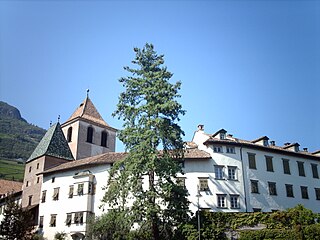
Muri-Gries Abbey is located in Bolzano, South Tyrol, Italy and was founded in 1845 as an offshoot of the former Muri Abbey in Aargau. It is a member of the Swiss Congregation of the Benedictine Confederation, mostly known for its wine-making.

Der Schlern is a German-language monthly for the study of science, research, art and culture related to South Tyrol.
The South Tyrolean Unterland or Bozen Unterland is a section of the Etschtal valley stretching from the regional capital Bolzano (Bozen) down the Adige (Etsch) river to Tramin and Salorno (Salurn). The area is known for its history, particularly regarding Rhaetic, Roman, and Germanic archaeological sites; its bilingualism, and its viticulture; the Gewürztraminer grape originated here.

Otto III, a member of the House of Gorizia, was Duke of Carinthia and Count of Tyrol from 1295 until his death. He ruled jointly with his younger brothers Louis and Henry VI.
Franz Thaler was an author from South Tyrol, a peacock quill embroiderer and a survivor of the concentration camp in Dachau and satellite camp in Hersbruck.
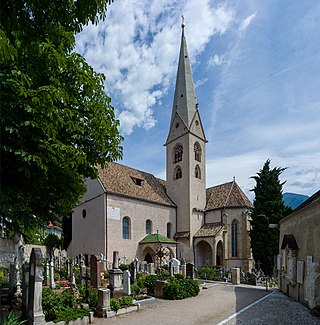
The Old Parish Church of Gries was until 1788 the parish church of the formerly independent municipality of Gries, which today forms part of the Gries-San Quirino district of Bolzano, South Tyrol (Italy). The Late Gothic church contains several precious works of art.
The following is a timeline of the history of the city of Bolzano/Bozen in the Trentino-South Tyrol region of Italy.

An Ansitz is a small residence designed for the lower nobility of the Germanic Alpine region.
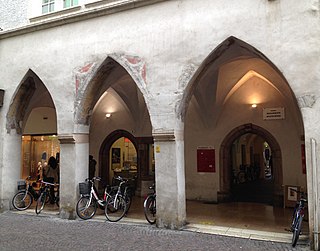
The Civic Archives in Bozen-Bolzano is the municipal archive of the city of Bolzano in South Tyrol, Italy. It is located in the old town hall and stores documents from over 700 years of civic and regional history.

The former Casa del Fascio in Bolzano was built between 1939 and 1942 in a rationalist style on a project by the architects Guido Pelizzari, Francesco Rossi and Luis Plattner, as the seat of the Italian Fascist Party and its collateral organisations, in Piazza del Tribunale. Since the end of World War II it has housed the State Financial Offices and other state bodies operating in South Tyrol.

The cathedral Maria Himmelfahrt is the parish church of the South Tyrolean capital Bolzano and cathedral of the Diocese of Bozen-Brixen. While the Bishop has resided in Bozen since 1964, the cathedra and the cathedral chapter remain in Brixen. Maria Himmelfahrt is therefore with Brixen Cathedral co-cathedral of the diocese.
















